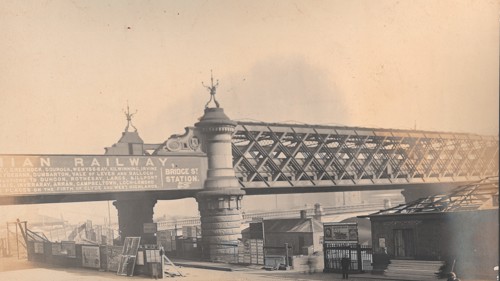Sir William Arrol & Co - Times Past

In partnership with the Glasgow Times, our archivists are exploring Glasgow's fascinating history. This week, Michael Gallagher writes about the Sir William Arrol & Co.
Glasgow has given the world many great things. It should come as no surprise that some of the Victorian era’s finest feats of construction were devised by one firm in the city’s east end: Sir William Arrol & Co.
William Arrol was born in Houston in 1839 and spent his childhood in Johnstone (where he worked in a local cotton mill) and Paisley (where he was a bobbin maker for J & P Coats), before becoming a blacksmith’s apprentice aged 14. He started his own boiler making company in Peel Street, Bridgeton, in 1868, then expanded into bridge building and public infrastructure works.
One of Arrol’s first big assignments came in 1876: the Caledonian Railway viaduct over the River Clyde that ran into the new Central Station. Only the piers now remain, standing next to the second bridge which was also built by Arrol in the first years of the 20th century.
The company was then entrusted with rebuilding the Tay Bridge, which collapsed tragically in 1879 causing 75 deaths. Arrol’s far superior replacement enhanced his firm’s reputation further; the only downside was that it moved William McGonagall to pen a sequel to his poem “The Tay Bridge Disaster”, often recognised as one of the worst of all time.
Soon thereafter Arrol won contracts for two high profile projects: the Forth Bridge and Tower Bridge in London. The Forth Bridge took seven years to complete and at its peak approximately 4,600 workers were employed in its construction. It was the largest steel bridge in the world at the time. In July 2015, UNESCO designated the bridge as a World Heritage Site recognising it as ‘an extraordinary and impressive milestone in bridge design and construction.’
Based at Dalmarnock Iron Works, the company continued to create bridges, cranes, workshops and many other construction projects when Glasgow was emerging as a key industrial city. Its reach was global, evidenced by its work on bridges as far afield as Egypt and Australia. Arrol’s contained an in-house engineering division which gave it greater flexibility and enabled it to develop new techniques in fields such as drilling and riveting.
Glasgow City Archives holds the records of Sir William Arrol & Co, which provide a fascinating insight into the company and its work.
William, who was knighted in 1890, was known for his boundless energy and strong work ethic. He often rose at 4am to pore over every detail of his projects. During one particularly busy spell for his firm, he is said to have spent Monday and Tuesday at the Forth Bridge, Wednesday at the Tay Bridge, Thursday at his works in Dalmarnock, then Friday and Saturday in London, working on Tower Bridge. Thankfully, he took Sundays off.
Sir William passed away in 1913 leaving behind a personal fortune of £337,456 – around £20 million today. Perhaps more importantly, he left a spectacular legacy of Glasgow’s industrial pre-eminence which is still felt around the world.
